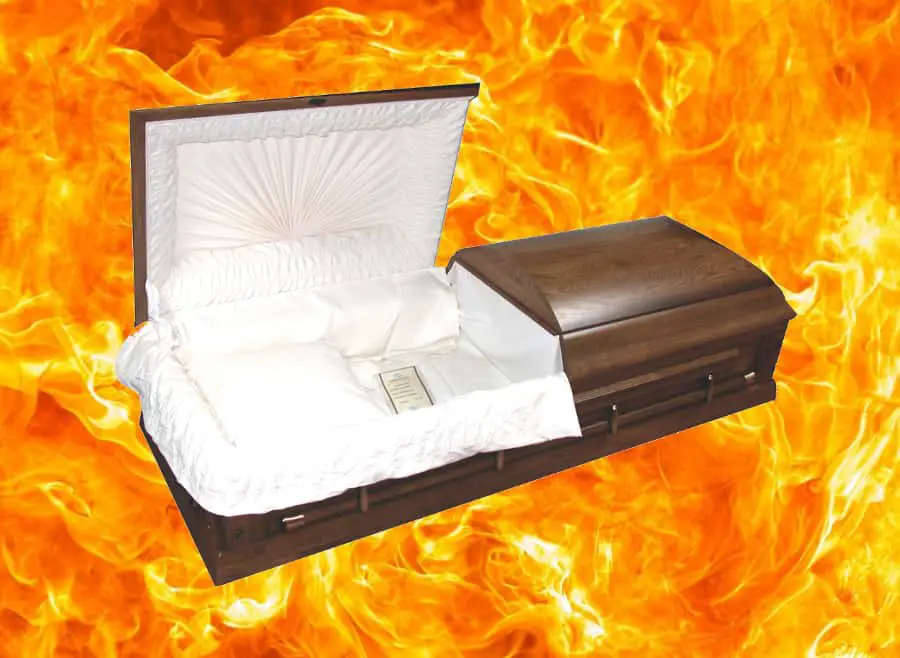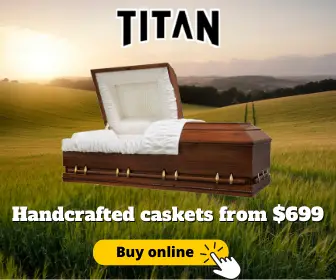Increasingly choosing cremation instead of burial, Americans are joining a global trend. Over 50% of Americans who die this year will be cremated. Handling the death of a loved one, are you prepared for the logistics? Do you still need a coffin? And will it be cremated too?
So, does that elaborate and often expensive coffin or casket get burned too?
Yes, the coffin will be the vessel that transports your loved one into the crematory, and it will be cremated along with the body. If the coffin doesn’t fit, not the right material or a rental, the body will be moved into a more suitable container for convenient delivery into the cremation chamber.
You may be wondering whether a coffin is even necessary, or struggling to decide what kind of coffin to buy, or agonizing over what kind of service to hold before the cremation.
If you are horrified by the mounting costs, please know you are not alone! And continue reading for the answers to some of your questions:

The lowest-costing cremation option
If your top priority is to save money, and a formal viewing of the body is not necessary, you should ask for “direct cremation” (or “simple cremation”). Make it absolutely clear to everybody you talk to in the process that you do not want any funeral or viewing services, embalming or cosmetic procedures for the body, or burial of the ashes. This is especially important when planning your own funeral.
You should expect to pay for the following:
- transportation of the body from the funeral home, mortuary, or place of death to the crematorium
- storage and refrigeration before the cremation date
- a cremation container used to transport the body into the crematory
- a container to place the ashes in.
Interestingly, the “cremation container” may also be called a “cremation coffin” or “cremation casket”. Some people may use these terms interchangeably with the simple terms “coffin” and “casket”.
Salespeople and funeral directors may pretend to be confused by your requests and may try to make you feel like an expensive coffin or casket is your only choice. Don’t fall for it. Just keep insisting on the cheapest cardboard container available for the purpose.
It’s sad to say, the markup on coffins is near extortionate and you shouldn’t let your grief (Speak to a professional today from the comfort of your home) be a tool used against you when planning the funeral of a loved one.
After cremation, the remaining bone fragments will be ground into “ashes”. A special container for the ashes is typically called an urn, and urns can be quite expensive. This may be worthwhile if you plan to keep the ashes. However, most Americans want their ashes to be scattered in the ocean or a lake, or a forest or garden, or somewhere else meaningful. So an expensive urn may seem wasteful (check out the affordable selection on OneWorld Memorials).
Fortunately, most crematoriums will provide a simple cardboard container free of charge or very cheap. If not, you can actually bring any container of your choice to put the ashes in, as long as it is large enough and won’t leak.
Another great option is to get the ashes made into a permanent piece of jewelry, you should check out the beautiful handcrafted pieces Mark Hamilton makes with cremains by visiting his site here.
Depending on where you live, the total cost of direct cremation without any extra services will probably be somewhere in the range of $500 to $1500.
Is it disrespectful to the deceased?
If this is your first time to be responsible for handling the logistics of a loved one’s death, you may be shocked by the price tags on coffins, urns, and funeral services. Being concerned about the budget is absolutely reasonable.
Unfortunately, we live in a culture that glamorizes expensive ceremonies. Salespeople, funeral home staff, and even your relatives and friends may give you the feeling that an as-cheap-as-possible cremation is disrespectful to the deceased.
Whatever else you may decide to do, it’s OK not to splash out on a very expensive casket if you are not having a big funeral where lots of people will see it. If you want to have the casket as the centerpiece of the ceremony, then you can look into renting one which will then be removed before the cremation begins. (see below)
Please be confident that it is absolutely no reflection of how you feel about your deceased loved one or friend. Your grief and respect have nothing to do with whether the deceased is buried or cremated, whether there is an extravagant memorial ceremony or none at all, or the total cost of the services and items involved.
If other relatives or friends of the deceased feel that your thriftiness is disrespectful, they should offer to pay for the services that they want. If they don’t, they have no right to criticize.
If you want to buy an attractive coffin or casket
The terms “coffin” and “casket” are often used interchangeably, but they are actually different categories: a coffin is a container that fits the shape of the human body, narrower at the head and feet, and wider in the middle; while a casket is an even rectangular shape.
You may be planning a simple viewing before the cremation or a full memorial service. If so, you might want a coffin or casket more attractive than the basic container offered by the crematorium. And if your service is held at a private home, funeral home, church, synagogue, temple, or other location before transportation to the crematorium, you may need to procure your own container.
It is possible to rent a coffin or casket, then transfer the body to a simple container for cremation. However, you may find the idea of displaying your loved one in a container previously occupied by other dead bodies to be distasteful or even nauseating.
In that case, you should tell the crematorium and funeral home staff that you wish to purchase an attractive coffin or casket that fits the requirements for cremation.
You should expect to do some research. Many funeral homes also have the facilities to do cremation, so you can begin by contacting all funeral homes in your area.
The staff should be able to give you some options for coffins and caskets, which will be delivered directly to the funeral home very quickly, and included in the total cost package. Just make sure the container you choose is also suitable for the crematory chamber.
If there are no funeral homes in your area that offer cremation after the funeral service, contact the crematorium nearest to your home and ask what kind of viewing service they will provide before the cremation.
After you have your selection of coffins and caskets provided by the funeral home or crematorium, search the internet and compare prices! There are at least hundreds of cremation-suitable models to choose from, and you can definitely order it by yourself and have it shipped to the funeral home or crematorium.
But again, whatever you choose, before you make the purchase make sure it meets the requirements of the crematorium. Coffins and caskets are quite expensive – ranging from around $700 to many thousands of dollars, plus a shipping fee in the hundreds of dollars – so be cautious.
The other option: renting
If spending hundreds or thousands of dollars on a coffin or casket that is just going to be destroyed in the cremation process bothers you, and you don’t mind displaying your loved one in a container that has been used by other grieving families in the past, you can consider renting one for the service and then having the body transferred to a simple container for the cremation.
This will give you so much more freedom to choose a style of your liking since you don’t have to worry about the rental coffin being suitable for the crematory chamber. If you want the powerful beauty of steel or immaculately polished wood, this may be the best choice for you!
Again, many funeral homes will provide attractive rental options. You can compare the cost of renting the model of your choice versus buying. And you can compare the cheapest attractive rental coffin offered by the funeral home with the cheapest similar models available for purchase on the internet.
Just keep in mind, you may be required to purchase an acceptable lining sheet, or “insert”, for the rental coffin.
Materials and styles of coffins and caskets
Please first consider a simple “cremation container” or “cremation casket”. Sometimes they are called “alternative containers”. Most of these are made of cardboard, and the cheapest will add little more than $100 to your cremation cost. You may find this type attractive enough for any viewing ceremony before the cremation.
The cardboard option is not only environmentally friendly and light on your budget, but it can also be customized with a design of your choice. The trend of “digitally printed cardboard caskets” has taken off in the past few years.
Depending on where you live, you might find wicker and bamboo coffins to be the norm. This can be even cheaper than cardboard, and even easier on the environment. Just make sure to ask if the crematorium will accept this.
If you have a higher standard for beauty, are willing and able to spend thousands of dollars, and feel at ease with the idea that the coffin will be cremated with the body, by all means, go for a wooden model made of oak or mahogany.
Donate your whole body to science
Nowadays, more and more people are expressing the sentiment that they don’t want their death to be a burden on relatives and friends. If you donate your whole body to science, you will be cremated at absolutely no cost to your relatives and friends!
But be clear, this is different from declaring yourself to be an organ donor. If you donate your whole body, to be used for scientific research or teaching in medical school, you may be asked to pay upfront to cover the costs associated with cremation, typically around $700.
For more details on this option, check out the Anatomical Board of the State of Florida.
And be sure to specify in your will what kind of memorial service, if any, you would like your family and friends to conduct, and allocate the funds for them to do so. Even without your body, it may be important for them to celebrate and remember you.




